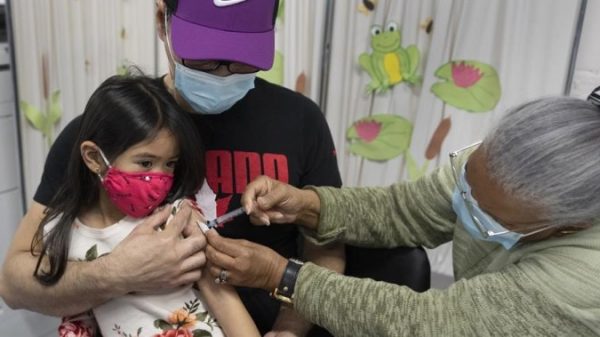A decade ago, as she waited in the visitation room of the Ohio prison where her cousin was serving out a life sentence, Nicole Fleetwood started to wonder about the art displayed on the walls — made by the people incarcerated there. She began asking questions about how people could find ways to create while being held in detention.
Her cousin has since been released from that prison, but Fleetwood’s captivation with the artwork and how the artists are able to express their humanity through it has become her life’s work.
“It started off informally and then it just grew into my being able to access over 70 currently and formerly incarcerated artists and to interview them and do deep dives into … how do you make art?” she said.
Her initial curiosity became “Marking Time: Art in the Age of Mass Incarceration,” a collection of works published in a book from more than 35 artists who are currently incarcerated, formerly incarcerated or have been personally affected by the prison system. It’s a culmination of Fleetwood’s efforts to collect and curate works from these artists into a traveling exhibit.
WATCH: How prison has shaped one artist’s view on social distancing
For Fleetwood, who was named a 2021 MacArthur fellow, the project was originally a way to reflect on her family’s legacy and what she could do to highlight what she considers a great injustice to her community.
“I had been thinking about the community in southwest Ohio where I grew up,” she said. “In a working class, working poor, black community that’s been just decimated by criminalization and imprisonment.”
After curating works for many years, she first presented the artwork in 2014 at a conference, which brought her pursuit into the national conversation. Since then, the project has continued to evolve and expand. The exhibit is currently set up in Birmingham, Alabama, where the incarceration rate per capita is higher than that of many other nations as a whole, according to the Prison Policy Institute.
“As it got more expansive, it also became more empowering because it wasn’t about the isolation of just one family’s experience, but about people coming together to really undo the system that is based in inequality and in reproducing the vulnerability of the most marginalized people,” Fleetwood said.
She explained that many artists were open to sharing their work as a way to help people understand that they’re human beings, not just “inmates” or “prisoners.”
Fleetwood also said many formerly incarcerated people use art as a bridge for reentry by establishing relationships with other artists and organizations even before their release. Organizations like Mural Arts Philadelphia help find employment opportunities for artists during their reentry.
The vast majority of these artists, Fleetwood said, continue to explore themes of incarceration after release, using art to bolster their social justice work.
Mary Enoch Elizabeth Baxter, whose work has been exhibited in the African American Museum of Philadelphia, is one artist that Fleetwood has featured. Baxter uses a variety of mediums like film and music to explore and critique the criminal justice system, pulling from her personal experience in prison and solitary confinement.
With the rise of movements like Black Lives Matter, Fleetwood believes people are paying more attention to injustices being enacted on vulnerable populations. She believes her project came out at a time when people are more receptive to hearing the stories she’s trying to share.
Nicole Fleetwood spoke to the PBS NewsHour about the exhibit, what it required to construct it and what the project means for those working to dismantle mass incarceration in the U.S.
This interview has been condensed and edited for clarity.

Tameca Cole’s “Locked in a Dark Calm,” 2016. Collage and graphite on paper. 8 1/2 x 11 inches. Courtesy of the artist, photo provided by Nicole Fleetwood
What led you to become an art historian and curator?
I appreciate that question because my undergraduate and graduate degrees are all interdisciplinary studies. I’ve always been interested in multi-disciplines: literature, art, race and ethnic studies. And actually, through interdisciplinary studies, I started to focus more and more on the visual culture of the United States and the importance of visual culture for disseminating ideas about race, gender, sexuality, identity categories, ideas about citizenship and systems of value that makes some people more vulnerable to state regulation and other people.
And so … I became an art historian, not by training, but by continuing to be guided by certain questions and concerns about inequality and value systems that really make certain people more precarious to punishment, to criminalization, to marginalization in society. And curating came about in the same kind of way. The more and more interested I got in art by incarcerated people, the more I needed to learn some skills and some tools for sharing that work broader than academic audiences. So I became a curator out of necessity.
I always say that I got an extra graduate degree just through having to do the work. To have that work really seen required that I move into these different environments.
What led you to focus on this kind of artwork?
In 2011-2012, after I wrote my first book, “Troubling Vision: Performance Visuality, and Blackness,” about American culture’s fixation on black visibility in media, whenever someone would invite me to give a lecture, I didn’t actually want to talk about it. I didn’t want to talk about a book that I’d already published.
I had been thinking for years about the community in southwest Ohio where I grew up, in a working class, working poor, Black community that’s been just decimated by criminalization and imprisonment. And that as I was coming of age, several of the people in my neighborhood, people my age, ended up [in prison]. I’ve never seen them again, like they were just erased. They were sentenced, incarcerated, some of them for life, they died in prison.
You know, it’s one thing to hear about it, like in mass media, it’s another thing to be in a neighborhood and to experience and to watch your cousin get swept up in the system. My cousin Allan, when he was 18, was sentenced to life in prison and he served 21 years and he’s now out and doing very well.
WATCH: In ‘Grief and Grievance,’ Black artists explore aspects of loss in contemporary life
Three weeks after I graduated from college, I was in a court house where he was being sentenced to life, and I committed to being in touch with him. We wrote letters and he would send me photographs. And when I visited him in the prison, I’d always see art in the visiting room. So I got very fascinated with art making that was happening inside prisons. And so [the project] started off informally, and then it just grew into me being able to access over 70 currently and formerly incarcerated artists and to interview them and do deep dives into what’s at stake. What does it mean to make art? How do you make art? How do you get material when literally the state is punishing you? How have you been able to take that experience and turn it into a space of incredibly immersive creativity?
Was it difficult to convince some people to display their artwork?
I would say, overwhelmingly, people have been incredibly enthusiastic. Actually, a lot of what kept this project going is other people who are system impacted: people who are on parole or currently in prison or somehow connected to the criminal legal system. They’ve been the ones guiding me. They say, “Oh, you should meet this artist, you should talk to this person.”
So the project actually kept expanding because of the generosity of people. To this day, I get a significant amount of mail from incarcerated people sharing experiences and art with me.
What common themes appear in the work you’ve found?
When I was working on “Marking Time,” it was kind of like walking through the dark, not knowing where I was going to be led. And as I was going back through the transcripts and interviews, there were overlapping things that were emerging.
One of the issues that emerged was the widespread use of isolation in U.S. prison. We always think of solitary confinement as a punishment that’s adjudicated to people who were already in prison for doing something wrong. That’s like the common understanding, when in fact it is used so widespread as a management tool, meaning to isolate people who are considered somehow a threat to the general run of a facility.
That could be because of their age category. For example, a young person under 18 who has been sentenced to an adult prison might be put in solitary confinement. Someone who is gender expansive and doesn’t fit into the binary category can be put in solitary confinement. A person who has the flu or is sick is also relegated to it. One of the artists in the book and exhibition, Mary Baxter, was in labor and was shackled while giving birth and then, after having her child, was actually put in solitary confinement as her medical recovery base.

Video still from Mary Enoch Elizabeth Baxter’s music video “Ain’t I a Woman.” Photo provided by Nicole Fleetwood
We’ve known for decades that nothing good comes out of solitary confinement, especially long term solitary confinement. It destroys people, it destroys sensory experience, it impacts mental health and it’s debilitating physically because a lot of times people can’t move more than two to three steps. I ended up writing a whole chapter about art made of solitary confinement. And it’s a hard chapter to read because not everyone in that chapter survives it.
Another common set of things that came up was what I call “penal space, time and matter.” These are the conditions under which people make art in prison.
Penal space is the confinement of a six foot by nine foot cell, or in some prisons, there’s workshop spaces or the gathering room or wherever artists can kind of craft space to make art.
Penal matter is materials, from prison documents to draw on or bed sheets as canvases or using paste as an adherent. One artist who’s currently in prison in Pennsylvania, Todd (Hyung-Rae) Tarselli has a collection of leaves from the prison yard and does these exquisite, beautiful paintings on top of leaves.
READ MORE: ‘Everybody wants to be seen’ — exhibit showcases LGBTQ artists in prison
And then another concept that came out across a lot of interviews was penal time. And that’s being confined to a cell for a period of time as punishment. We’ve made that seem like it’s logical, but it’s not logical. It’s literally a system that we created where we somehow think that time and a criminal infraction can line up in a way that is justifiable, but it’s just random. The people who create sentencing guidelines are people who’ve never been in prison. So what it means for you or me to live in an apartment for five years is very different from being put in a six foot nine foot cell for five years. Those are very different temporalities.
What I get so fascinated by, though, is how incarcerated people would say that they take that punitive time, that time as punishment, and turn it into what many described as a monastic practice. They turn it into creative time, deep dive time, trying to study other artists, time to collaborate. It’s a way of managing when one has very little control over one’s life.
What are some surprising things you’ve found while working on this project?
Another thing that came up was the predominance of portrait making as the most common form of art making in prison. I have a whole chapter on portrait making because it serves so many purposes.
For one, it’s quite literally for many people a counter image to their mugshot or their prison I.D. card. People who are in prison are walking around with this image of themselves that the state has forced upon them as a “bad person” and so portrait making becomes this very important mode of self-representation, of self-fashioning, of self-discovery.
It’s also a currency in prison. If you’re a really good portrait artist, you’re in high demand. People will give you coffee or, you know, commissary goods for a portrait of their child and it can become this relational practice where someone will get a portrait commissioned of a loved one and then mail it home. And so it’s a way of also staying connected with family.
The cover of my book is a series by Mark Loughney, he’s currently in prison in Pennsylvania. He does these 20 minute graphite sketches of other incarcerated people. The series is called “Pyrrhic Defeat” and he’s amassed over 740 of these portraits that he’s been working on since 2014. It’s his way of documenting the toll of mass incarceration from the side of captivity. It’s a very, very powerful series. It’s really important that they’re always shown together.

Mark Loughney’s “Pyrrhic Defeat: A Visual Study of Mass Incarceration,” 2014-present. Graphite on paper (series of 725 drawings). Each 12 x 9 in. Courtesy of Mark Loughney, photo provided by Nicole Fleetwood
Were there any major roadblocks you had to pass?
Getting in contact with some of the artists was challenging. One artist featured in the project, who passed away on the streets, is Ronnie Goodman. He was a portrait artist and, when he was released, he spent like a decade unhoused in San Francisco. As he was unhoused, it took me like two years to be able to interview him.
When I started doing this research 10 years ago, I had a very difficult time getting funding for it. I want to say it was about four years before I started getting grants to support the work. I would have people say, “you’re trying to valorize thugs,” like literally use that kind of language.
But I do think in the past few years a lot of the uprisings and Black Lives Matter have really helped. I feel like people are having more exploratory conversations about why we over incarcerate. I do think that a lot of the social movements of the past few years have helped us see the correlation between the vulnerability on the streets of certain bodies and the hyper incarceration of those bodies. I feel like the project came out at a critical moment where people can receive the work more thoughtfully.













































